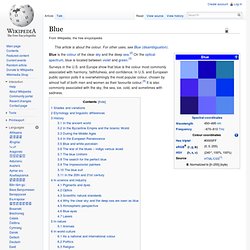

Online Etymology Dictionary. C.1300, bleu, blwe, etc., from Old French blo "pale, pallid, wan, light-colored; blond; discolored; blue, blue-gray," from Frankish *blao or some other Germanic source, from Proto-Germanic *blæwaz (cognates: Old English blaw, Old Saxon and Old High German blao, Danish blaa, Swedish blå, Old Frisian blau, Middle Dutch bla, Dutch blauw, German blau "blue"), from PIE *bhle-was "light-colored, blue, blond, yellow," from PIE root bhel- (1) "to shine, flash" (see bleach (v.)).

The same PIE root yielded Latin flavus "yellow," Old Spanish blavo "yellowish-gray," Greek phalos "white," Welsh blawr "gray," Old Norse bla "livid" (the meaning in black and blue), showing the usual slippery definition of color words in Indo-European The present spelling is since 16c., from French influence (Modern French bleu). The exact color to which the Gmc. term applies varies in the older dialects; M.H.G. bla is also 'yellow,' whereas the Scandinavian words may refer esp. to a deep, swarthy black, e.g.
Blue. Surveys in the U.S. and Europe show that blue is the colour most commonly associated with harmony, faithfulness, and confidence.

In U.S. and European public opinion polls it is overwhelmingly the most popular colour, chosen by almost half of both men and women as their favourite colour.[4] It is also commonly associated with the sky, the sea, ice, cold, and sometimes with sadness. Shades and variations Blue pigments were originally made from minerals such as lapis lazuli, cobalt and azurite, and blue dyes were made from plants; usually woad in Europe, and Indigofera tinctoria, or True indigo, in Asia and Africa. Today most blue pigments and dyes are made by a chemical process.